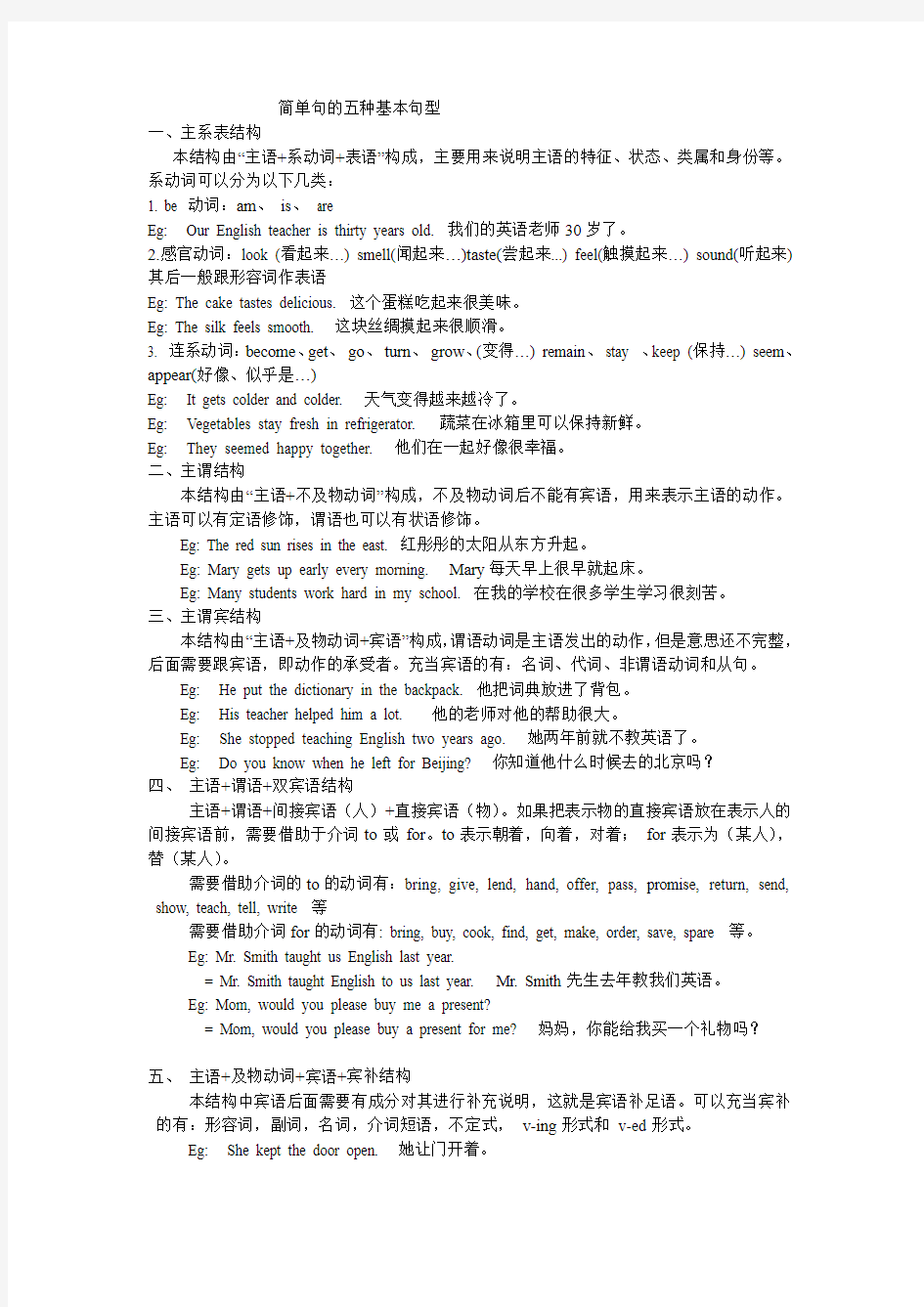简单句的五种基本句型

- 1、下载文档前请自行甄别文档内容的完整性,平台不提供额外的编辑、内容补充、找答案等附加服务。
- 2、"仅部分预览"的文档,不可在线预览部分如存在完整性等问题,可反馈申请退款(可完整预览的文档不适用该条件!)。
- 3、如文档侵犯您的权益,请联系客服反馈,我们会尽快为您处理(人工客服工作时间:9:00-18:30)。
简单句的五种基本句型
一、主系表结构
本结构由“主语+系动词+表语”构成,主要用来说明主语的特征、状态、类属和身份等。系动词可以分为以下几类:
1. be 动词:am、is、are
Eg: Our English teacher is thirty years old. 我们的英语老师30岁了。
2.感官动词:look (看起来…) smell(闻起来…)taste(尝起来...) feel(触摸起来…) sound(听起来)其后一般跟形容词作表语
Eg: The cake tastes delicious. 这个蛋糕吃起来很美味。
Eg: The silk feels smooth. 这块丝绸摸起来很顺滑。
3. 连系动词:become、get、go、turn、grow、(变得…) remain、stay 、keep (保持…) seem、appear(好像、似乎是…)
Eg: It gets colder and colder. 天气变得越来越冷了。
Eg: Vegetables stay fresh in refrigerator. 蔬菜在冰箱里可以保持新鲜。
Eg: They seemed happy together. 他们在一起好像很幸福。
二、主谓结构
本结构由“主语+不及物动词”构成,不及物动词后不能有宾语,用来表示主语的动作。主语可以有定语修饰,谓语也可以有状语修饰。
Eg: The red sun rises in the east. 红彤彤的太阳从东方升起。
Eg: Mary gets up early every morning. Mary每天早上很早就起床。
Eg: Many students work hard in my school. 在我的学校在很多学生学习很刻苦。
三、主谓宾结构
本结构由“主语+及物动词+宾语”构成,谓语动词是主语发出的动作,但是意思还不完整,后面需要跟宾语,即动作的承受者。充当宾语的有:名词、代词、非谓语动词和从句。
Eg: He put the dictionary in the backpack. 他把词典放进了背包。
Eg: His teacher helped him a lot. 他的老师对他的帮助很大。
Eg: She stopped teaching English two years ago. 她两年前就不教英语了。
Eg: Do you know when he left for Beijing? 你知道他什么时候去的北京吗?
四、主语+谓语+双宾语结构
主语+谓语+间接宾语(人)+直接宾语(物)。如果把表示物的直接宾语放在表示人的间接宾语前,需要借助于介词to或for。to表示朝着,向着,对着;for表示为(某人),替(某人)。
需要借助介词的to的动词有:bring, give, lend, hand, offer, pass, promise, return, send, show, teach, tell, write 等
需要借助介词for的动词有: bring, buy, cook, find, get, make, order, save, spare 等。
Eg: Mr. Smith taught us English last year.
= Mr. Smith taught English to us last year. Mr. Smith先生去年教我们英语。
Eg: Mom, would you please buy me a present?
= Mom, would you please buy a present for me? 妈妈,你能给我买一个礼物吗?
五、主语+及物动词+宾语+宾补结构
本结构中宾语后面需要有成分对其进行补充说明,这就是宾语补足语。可以充当宾补的有:形容词,副词,名词,介词短语,不定式,v-ing形式和v-ed形式。
Eg: She kept the door open. 她让门开着。
Eg: They named their son Jack. 他们给儿子取名杰克。
Eg: They invited me to speak at the meeting. 他们邀请我在会上讲话。
Eg: I saw him playing in the river. 我看到他正在河里玩耍。
Eg: We want the work finished by Friday. 我们希望这个工作在周五之前完成。
练习题:
Translations
1. 在教室里我们一定要保持安静。
2. 她的工作是在幼儿园照看孩子.
3. 这个故事听起来很有趣.
4. 树叶在秋天会变成黄色.
5. 这个会议将持续两个小时.
6. 这位先生能流利地说三种语言.
7. 今晚你能把你的汽车借给我吗?
8. 他发现自己的新工作相当乏味.
并列句
并列句由两个或两个以上并列而又独立的简单句构成。在并列句中,这些简单句常由并列连词连在一起。并列连词所连接的简单句被称为分句。
常见的并列连词
1.表示递进或顺承关系: 常用的并列连词有: and, not only…but also…等
Eg: He had plenty of money and he spent it freely.
他有很多的钱,并且他花钱很随便.
Eg: Not only does he study well, but also he likes to help others.
他不仅学习好,而且还乐于助人.
2. 表示选择关系:常用的并列连词有:等。
Eg: Either you are right, or I am.
要么你对,要么我对。
Eg: Shall we go to the cinema or stay at home?
我们是去电影院还是待在家里?
3.表示对比、转折关系:常用的并列连词有but, yet, while 等。
Eg: Jane said she was ill, but/yet I saw her in the street just now.
简说她病了,但我刚才在街上看到了她。
Eg: He likes pop music ,while I am fond of folk music.
他喜欢流行音乐,而我喜欢民间音乐。
4. 表示因果关系:常用的并列连词有so, for等。
Eg: The shops were closed, so I didn’t get anything to eat.
商店都关门了,所以我没有买到任何吃的东西。
Eg: It must have rained last night, for the ground is wet.
昨晚一定下雨了,因为地上是湿的。
练习题(用正确的并列连词填空)
1. He is a shy man,______ he is not afraid of anything or anyone.
2. Some animals carry seeds from one place to another,______ plants can spread to new places.
3. I am thirsty,_____ it is too hot today.
4. I was glad to meet Jenny again,_______ I wanted to spend all day with her.
5. It’s not easy to change habits, ______ with awareness and self-control, it is possible.
